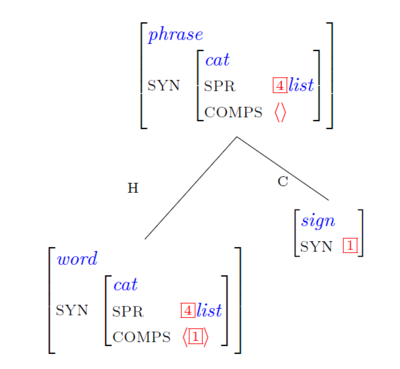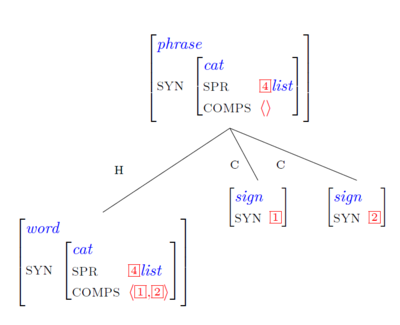Syntax 1 Wiki: Week 6: Difference between revisions
| Line 47: | Line 47: | ||
===Head-Specifier Phrases=== | ===Head-Specifier Phrases=== | ||
A head-specifier phrase can be formed by combining a sign [= the head daughter] with a second | |||
sign [= the non-head daughter] whose syntactic category can be unified with the syntactic category on the word’s spr list: | |||
===Head-Modifier Phrases=== | ===Head-Modifier Phrases=== | ||
Revision as of 22:28, 29 June 2019
Types of Phrases
Head-Complement Phrases
A head-complement phrase can be formed by combining a word [= the head daughter] with 1 or 2 signs [= the non-head daughter(s)] whose syntactic categories can be unified with the syntactic categories on the word’s comps list.
Schema 1: The head licenses a single complement
This schema licenses the following structure:
XP -> X + COMPS
Examples:
- [PP [H of][C Lilly]]
- [AP [H fond][C of Lilly]]
- [VP [H likes][C Fido]]
- [VP [H speaks][C to Fido]]
Schema 2: The head licenses two complements
This schema licenses the following structure:
XP -> X + COMPS
Examples:
- [VP [H show][C me][C Frankfurt]]
- [VP [H give][C the book][C to the student]]
- [VP [H put][C the book][C on the table]]
Head-Specifier Phrases
A head-specifier phrase can be formed by combining a sign [= the head daughter] with a second sign [= the non-head daughter] whose syntactic category can be unified with the syntactic category on the word’s spr list:
Head-Modifier Phrases
Phrase Formation
Here is the file that we went through in class this week:
File:Phrase-Formation-Version3.pdf
Navigation:

